#Place de Bretagne
Explore tagged Tumblr posts
Text
The tomb of Chateaubriand (1768-1848), famous French writer, mostly known for his part in the romanticism movement.


It is located on the Grand Bé islet, a few feets away from Saint-Malo intramuros and accessible during low tide. Chateaubriand wanted to be buried here so he could forever hear the sound of waves and wind, the same sounds that welcomed him to life when he was born in that city. The mayor accepted after some issues, and the writer was finally able to build his tomb, ten years before his death. About a century later, during WWII, Saint-Malo was heavily bombed and nearly destroyed, and the tomb also received some dammage. That is why it looks kinda recent when we see it today. While restoring it, it was decided to remove the separation facing the see and to erase his name from the grave, because that was more correct regarding to his last wills. Only a plaque was put on a small wall behind (the islet is full of diverse ruins) saying that a writer is resting here and doesn't want to be disturbed.

The tomb before the war (source here)

A plaque about him inside the city walls
#françois-rené de chateaubriand#chateaubriand tomb#saint malo#litterature#romanticism#breton history#bretagne#bzh#also bro has good taste in resting places
13 notes
·
View notes
Text






Troisième étape de mon périple dans l'Ouest pour retrouver des ami(e)s lointain(e)s : Christian en Bretagne, près de Brest, il y a un mois déjà.
Ici Lanildut, au bord de l'Aber Ildut. On y voit des Nombrils-de-Vénus (dernière photo), des primevères, un cheval, une jolie petite église (décor baroque, tout de blanc et d'or et voûte en coque de bateau) et...un obélisque ?!?
En fait, j'ai appris sur place que c'est la modèle "réduit" de l'Obélisque de la Place de la Concorde à Paris. Et pourquoi ici ? C'est que le granite utilisé pour le socle de ce monument parisien vient d'ici.
#bretagne#lanildut#aber#aber ildut#primevère#nombril-de-vénus#botanique#cheval#obélisque#obélisque de louxor#place de la concorde#paris#granite#moustache#baroque
2 notes
·
View notes
Text
i looooooooove being home...................
#prettymuch the classic place to be.............. big mug of tea + kittycats bothered + bagel consumed.......... peace & love on planet earth#kinda wanna write gay ass nhw shit. kinda wanna write something wretched. should probably start on my matiere de bretagne paper thats due#monday instead.#txt
1 note
·
View note
Text
Witches and the Genius Loci: Folkloric Methods of Contact and Communion
The witches of old knew how to speak with the land. They didn’t just live in the wild, they wove themselves into its fabric, calling on the hidden ones in the earth, water, and wind. How did they do it? The answers would be as varied as the forests and fields they walked. But there are patterns we can see in all of them. Here are some of the ways I have discovered witches (in European folklore) reached out to the spirits of the land.
𖤐 Offerings at Spirit Dwellings
A witch rarely arrived empty-handed. Milk poured at the base of an ancient tree, ale left at the mouth of a cave, a bit of bread crumbled into a stream, these were ways to invite the unseen to draw near. Scottish folklore describes the gruagach, a guardian spirit, receiving libations of milk at stones and riverbanks (Campbell, Superstitions of the Highlands and Islands of Scotland, 1900). In Belgium and the Netherlands, witches were accused of offering beer and bread to the duivel, a local spirit often conflated with the Devil in later Christianized accounts (De Blécourt, Het Duivelspact, 1993).
𖤐 By Bone and Blood
In Scandinavian folklore, the practice of bjarmic magic involved burying bones to anchor spirits to the land, while Livonian witches were said to whisper their desires into a skull before placing it in the earth (Rääbis, Eesti Rahvapärimus ja Nõiakunst, 1926). In the 17th-century Scottish witch trials, accused witches described sealing pacts with land spirits by pricking their fingers and pressing the blood into soil or stone (Pitcairn, Ancient Criminal Trials in Scotland, 1833).
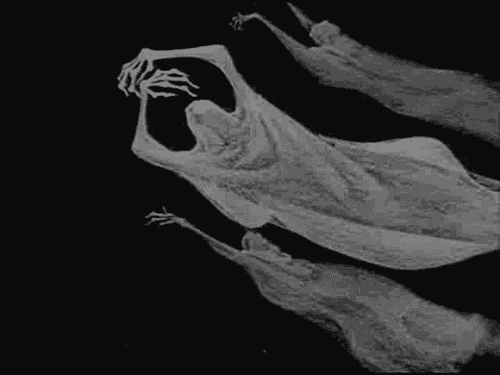
𖤐 Spirit-Flight and Dreamwalking
Witches didn’t always wait for spirits to come to them. Many traveled in spectral form, slipping into trance states with the help of charms or salves to reach spirits. The Trollenfrauen of German folklore and the Heks of Scandinavian folklore were said to enter deep sleep while holding a stone, allowing them to fly in spirit to the places where land spirits dwelled (Müller, Sagen aus Westfalen, 1857). In 17th-century witch trials from Flanders, accused witches claimed to lie still in darkness, feeling themselves lifted away to converse with spirits at crossroads and hollow hills (Proces tegen Tanneken Sconincx, 1606).
𖤐 Bone Charms & Rattles
A witch’s tools were often made from the dead. Flemish folklore mentions witches carrying duivelsfluitjes—small bone whistles said to call spirits when blown at twilight (De Meyer, Volksverhalen uit Vlaanderen, 1970). The bohnenzauber of Germanic folklore involved threading small bones together to create a rattling charm that stirred spirits of the wild (Grimm, Deutsche Mythologie, 1835).
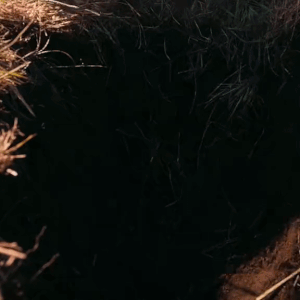
𖤐 Turning Up the Soil
Some witches were accused of whispering into the ground, digging their fingers into the soil as they spoke. In Swedish folk belief, jordfastan involved burying a charm/offering (usually a piece of cloth or a coin) under a tree to call on spirits of the land (Hylten-Cavallius, Wärend och Wirdarne, 1863). Scottish trial records mention witches placing coal or burned bones in the earth as a form of spirit-binding magic (Pitcairn, Ancient Criminal Trials in Scotland, 1833).
𖤐 Skin-Turning and Familiars
In Breton folklore, witches who wished to meet the hidden spirits of the woods were said to transform into black dogs or other beasts before travelling into the deep forest (Sébillot, Le Folklore de la Bretagne, 1904). In Scotland, it was believed that witches who took the form of hares or crows could cross into the spirit world more easily (Popular Tales of the West Highlands, Campbell, 1860).
𖤐 Betwixt Earth and Water
The land’s voice is loudest in the places where two worlds meet. Marshes, riverbanks, and tidal flats; these places belonged to neither land nor water, making them perfect for spirit-calling (my favourite method). In English and Welsh folklore, witches were said to stand barefoot in water at night, calling on spirits with secret words (Henderson, Folklore of the Northern Counties of England, 1866). In Estonia, it was believed that standing in a bog at sunset allowed one to hear the voices of spirits whispering in the wind (Loorits, Eesti Rahvausund, 1949).

Seeking out the spirits of the land is integral to building a foundational practice in witchcraft and connecting to your landscape. It is these spirits that grant you access to the powers of the land that you require to make your works work.
#folk witchcraft#traditional witchcraft#witchcraft#traditional witches#folk witch#folk witches#witch#trad witch#folklore#spells#spirit work#genius loci#witching spirits#spirits#spirits of the land#witch tips#beginner witch tips
130 notes
·
View notes
Text
Black Butler & Celtic Legend Part 1 - The Omen of The Dragons
Alright y'all, back on my medieval French Celtic literature shit. Excuse my ADHD ass hopping from theory to theory. I'm excited and sad about this one as it's my prediction for Undertaker's final fight - and it's not looking so good 😞
In Part 2 of my French Crown Jewels Series I theorized that Undertaker is in possession of some of the gemstones he recovered from the Order of the Golden Fleece insignia for Louis XV. This contains, among other gems, the original diamond from which the Phantomhive family ring was made (referred to as The Hope Diamond in season 1 of the anime). I theorized that within the insignia, Undertaker is represented by le Côte-de-Bretagne, the spinel carved into a red dragon.
And I think Undertaker is also represented by the red dragon in the Arthurian tale of King Vontigern and his construction woes - The First Legend of Merlin.
In this legend a monarch is attempting to build a tower above a pool of water, and when the foundation fails each night, he's advised that in order to successfully build the tower he must sacrifice a half-human child. However upon digging into the foundation he finds two dragons fighting, one representing the native Britons, the other representing the invading Saxons...

LET'S TALK ABOUT DRAGONS BABY.
Usual disclaimer - I have not been able to find evidence of this legend being discussed before in relation to Black Butler. Please tell me if it has.
A Very Brief & Simplified History of Brittany
First off, I want to clarify a few things about Brittany, France, just in case anyone's confused. If you're not confused about the relationship between Britons and Bretons, feel free to skip this part!
Brittany (French: Bretagne) is a peninsula, historical country and cultural area in the north-west of modern France, covering the western part of what was known as Armorica in Roman Gaul.
In the 6th century, Celtic people (Britons) fleeing the Anglo-Saxon invasion immigrated from Great Britain to Brittany, which was then a part of Armorica (meaning land by the sea).
By the 11th century, Brittonic-speaking populations had split into distinct groups: the Welsh in Wales, the Cornish in Cornwall, the Bretons in Brittany, the Cumbrians of the Hen Ogledd ("Old North") in southern Scotland and northern England, and the remnants of the Pictish people in northern Scotland.
So by the 11 century, the Britonic people have separated into distinct cultural and geographical groups, and have developed their own distinct languages - but the Welsh, Cornish, and Breton people all descend from the same ethnic group, the people who had inhabited the British Isles since the iron age (800 BC) and spoke Brittonic. The Irish, Scottish, and the Manx (those who inhabit the Isle of Mann) descend from those who spoke Goidelic (Gaelic).
Brittany became an independent kingdom and then a duchy before being united with the Kingdom of France in 1532 as a province governed as a separate nation under the crown. Brittany is the traditional homeland of the Breton people and is one of the six Celtic nations, retaining a distinct cultural identity that reflects its history.
When Undertaker was alive in the 14th century, Brittany was ruled by the Dukes of Brittany. In 1532 they officially became a part of France, but they've always retained a unique identity and there is a strong separatist movement today to seek further independence from France. Brittany is sort of the 'Québec' to France's 'Canada'.
The most relevant information to know is that before the middle ages, the people who inhabited the regions now known as Wales and Brittany shared a heritage and a common tongue. The legend of King Arthur takes place in both England and Brittany (I believe the Isle of Avalon in the world of Black Butler will be off the coast of Brittany) and Arthur and his companions are important historical/mythological figures in both Welsh and Breton culture.
Historia Regum Britanniae
I am going to focus on analyzing the Omen of the Dragons as it appears in The History of the Kings of Britain or Historia regum Britanniae, a work of historical fiction that was written in the 12th century. It chronicles the lives of the Kings of Britons from the founding of the British nation up until the Anglo-Saxons assumed control of much of Britain around the 7th century. Historia regum Britanniae is one of, if not the central piece of The Matter of Britain, a body of medieval literature associated with Great Britain, Brittany, and their legendary kings and heroes, particularly King Arthur. The lais of Marie de France, one of which I detailed in my Rossignol theory post, are also part of The Matter of Britain.
The First Legend of Merlin as portrayed in Historia Regum Brittanie
The First Legend of Merlin revolves around the characters of the half-human boy Merlin/Ambrosius and the Monarch, King Vortigern.
It should be noted that this legend is sourced from an already existing story and that the figure of Merlin is imposed onto the real life 5th century historical figure Ambrosius Aurelianus. Ambrosius was a war leader of the Romano-British who won an important battle against the Anglo-Saxons.
King Vortigern himself was a native Briton, but he is portrayed to be a betrayer of his own people - or at the very least, an easily manipulated fool. He invited the Saxons to England - brilliant fucking idea, mate - and married a Saxon.
Vortigern was a 5th-century British ruler best known for inviting the Saxons to Britain to stop the incursions of the Picts and Scots and allowing them to take control of the land. He is regularly depicted as a villain or, at best, weak-willed and unable to control the Saxons once he arranged for, or encouraged, their arrival in Britain.
In the legend, King Vortigern has lost all his other fortified holds, so he asks his advisors/ 'magicians' for advice and they tell him to build another. Seems kind of obvious to me... Except all work that they do vanishes overnight.
At last he had recourse to magicians for their advice, and commanded them to tell him what course to take. They advised him to build a very strong tower for his own safety, since he had lost all his other fortified places. Accordingly he made a progress about the country, to find out a convenient situation, and came at last to Mount Erir, where he assembled workmen from several countries, and ordered them to build the tower. The builders, therefore, began to lay the foundation; but whatever they did one day the earth swallowed up the next, so as to leave no appearance of their work.
So Vortigern asks the magicians and they advise him to take the next logical course of action - child sacrifice, my liege, duh!
Vortigern being informed of this again consulted with his magicians concerning the cause of it, who told him that he must find out a youth that never had a father, and kill him, and then sprinkle the stones and cement with his blood; for by those means, they said, he would have a firm foundation. Hereupon messengers were despatched away over all the provinces, to inquire out such a man.
Now, at this my ears perked up like a fucking dog's. A youth that never had a father - that's a phrase that sounds like it could have been subjected to many a translation. After all, what does a child that never had a father mean? A child who was hatched from an egg? A kid whose dad went out to buy cigarettes and never came back? An orphan? A bastard? A child whose father was dead before they were even conceived?
Sure enough, when I scrounged around for another translation:
“The child must be borne of both woman and demon.”
And yet another interpretation merely states that the child cannot have a "mortal father".
His wizards claim that only by mixing in the blood of a child who has no mortal father will he make the foundations sound.
Ancient engineering is a trip, eh? I so love living in a time where we don't rely on mixing the blood of children into our concrete to prevent a sinking foundation.
Now, as to what Vortigern was attempting to build... Sometimes it's a "fortress", sometimes it's a "citadel", but most often the translation reads as a "tower". Another aspect of the legend remains consistent - the construction is always occurring either above or next to a body of water.
So a monarch is trying to build a structure (a tower over water), and is mysteriously unable to begin his project. His advisors tell him in order to proceed, he must sacrifice a child - one sired by a non-mortal upon a mortal woman.
Monarch/Warlord = King Vortigern = Queen Victoria
Structure over water = tower above pool = Tower Bridge over the Thames
Monarch's advisors = Vortigern's magicians = John Brown
Half-mortal child = Ambrose/Merlin = Vincent Phantomhive

Tower bridge under construction in 4x11
It's long been speculated that the events of December 14th, 1885 (namely, the murder of Vincent Phantomhive) are connected to the Tower Bridge, a project Prince Albert took a particular interest in. It began construction on April 22, 1886 (around four months after Vincent's murder) and is referenced several times in the manga...and in season 1 of the anime, the unfinished bridge is where the final confrontation between Sebastian and Ash/Angela takes place.


Sebastian & the angel Ash on the unfinished Tower Bridge in 1x24. Souls forming a seal above the bridge while the city of London burns in 1x24.
The bridge in the anime is built with/contains human sacrifices, and Sebastian states in all likelihood it was Ash/Angela (the advisor) who instructed Victoria (Vortigern) to build the bridge.
Ash states that "no demon must be allowed to enter through this gate" and that soon "all of eastern London will be safe from impurity". Eastern, specifically 👀 remember this for later...
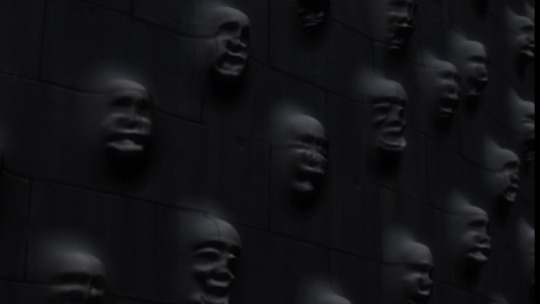
Horrible CGI human sacrifices in the bridge's foundation in 1x24
Back to the legend - the kings advisors go searching and find such a child who has no father, a boy whose mother claims to have laid with none other than a being who had long haunted her before lying with her in the shape of a beautiful young man. The king consults his advisor, who tells him that Merlin's father was likely an incubus.
For, as Apuleius informs us in his book concerning the Demon of Socrates, between the moon and the earth inhabit those spirits, which we will call incubuses. These are of the nature partly of men, and partly of angels, and whenever they please assume human shapes, and lie with women. Perhaps one of them appeared to this woman, and begot that young man of her."
Further versions of the legend add that Merlin/Ambrose is actually created as the antichrist. However Merlin is never portrayed as a malevolent force; having been baptized by his mother, he is freed from the Devil's influence, and yet still has the kick-ass powers. You get the best of both worlds, I guess.
The Omen of The Dragons
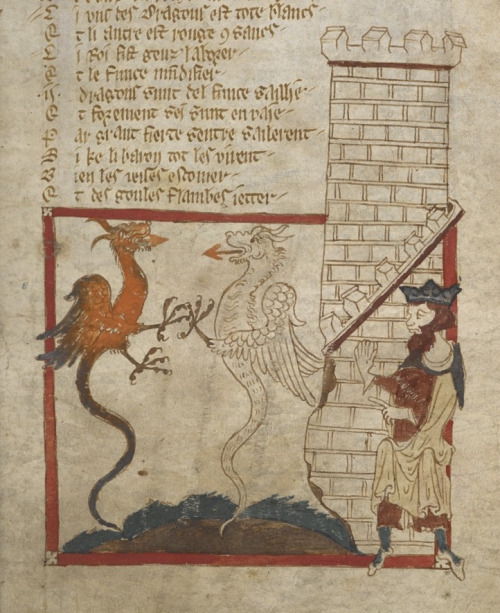
Merlin speaks with the king and when he finds out his intent is to sacrifice him, he reasonably suggests to him and his followers that before you go around sacrificing children maybe you should take a look at what's underneath the tower! And for this, they name him a prophet. Turns out common sense is magical! So they dig up the ground, and they find a pond underneath the tower which has been the cause of the foundation sinking.
Then said he again to the king, "Command the pond to be drained, and at the bottom you will see two hollow stones, and in them two dragons asleep." The king made no scruple of believing him, since he had found true what he said of the pond, and therefore ordered it to be drained: which done, he found as Merlin had said; and now was possessed with the greatest admiration of him. Not were the rest that were present less amazed at his wisdom, thinking it to be no less than divine inspiration.
Lo and behold, when they look they find two dragons, just as Merlin had predicted. The translation here is a bit misleading - the true spirit of Vortigern's reaction seems to be more along the lines of fearful reverence - he and his men were intimidated by Merlin/Ambrose's abilities.
The dragons, one red and one white, wake and fight each other with fire over the lake as the king looks on.
As Vortigern, king of the Britons, was sitting upon the bank of the drained pond, the two dragons, one of which was white, the other red, came forth, and approaching one another, began a terrible fight, and cast forth fire with their breath. But the white dragon had the advantage, and made the other fly to the end of the lake. And he, for grief at his flight, renewed the assault upon his pursuer, and forced him to retire.
So the white dragon, who represents the Saxons, triumphs over the red dragon, who represents the Britons. They fight over a body of water, and cast fire with their breath. In the end, the white dragon defeats the red dragon.
I fear this does not bode well for Undertaker.
Undertaker's Fate
Within the insignia for the Order of the Golden Fleece of Louix XV, the Spinel carved into a red dragon is literally called "the coast of Brittany". Here, the red dragon represents the Brittonic people from whom the Bretons descended. Undertaker is the Celtic dragon.
As for the white dragon, who represents the Saxons - I believe this will be John Brown, servant of Queen Victoria. Queen Victoria is herself descended from the Anglo-Saxon regime of England, her mother was a Saxon, as was her husband/cousin Prince Albert. Worth noting that king Vortigern, though a native Briton, married a Saxon.
Undertaker has outright stated that he does not care for Queen Victoria - but there are hints in the events of his past that his feelings towards her are a bit more strong than dislike. I think it's more accurate to say he hates her guts, especially after Claudia's death.
Queen Victoria was born in May of 1819. The massacre at Reaper HQ (a far cry from Undertaker's previous behaviour working as a reaper) likely occurred in 1819 as well. This was also the year in which the name "Cedric" first appeared in the newly published novel 'Ivanhoe'. May 1819 was also when Keats wrote "An Ode to a Nightingale", which is the cornerstone of my "Rossignol" last name theory. 1837 is the year in which Queen Victoria ascended to the throne - this lines up with the date when Undertaker officially deserted the reapers, taking his death scythe with him. 1847 is also the year of death for Undertaker's first chronological locket, Molly G.
These dates aligning link Undertaker's rebellion against his superiors to Victoria's rise to power. However, a 1v1 of Grandma Vicky vs Grandpa Reaper probably wouldn't be all that compelling of a fight.
Enter Queen Victoria's servant (in real life, and in the anime) John Brown.

John Brown in 4x10 - Sick Shades, Bro! Not conspicuous at all!
John Brown was a real person who served Queen Victoria in the aftermath of Prince Albert's death (and there is speculation that he and Vicky had an affair). But the real John Brown died on March 27, 1883 - and as I've discussed at length, Yana seems to be deliberate in the timing of significant events in relation to real world historical figures. That the 'real' John Brown in the manga died 2 years before Vincent Phantomhive was murdered is not a coincidence - rather, I think something else assumed John Brown's identity upon his death, and may have convinced Queen Victoria that Vincent Phantomhive needed to die...
There's been a lot of speculation about what John Brown is; another reaper, a demon, or an angel*. But he is most definitely not human. Not with those fuck-ass snow goggles.
*For the record, I think John Brown is indeed an angel.
Both characters of John Brown and Ash fill the same roles as the Queen's closest protector and advisor - the 'magicians' to Victoria's 'Vortigern'. The White Dragon Undertaker fights will not literally be Queen Victoria, but John Brown - and it seems Undertaker, GOAT that he is, will have finally met his match.
I think this will be Undertaker's final act in the manga, to reenact the fight between the red dragon and white dragon over the water by the half-built tower as detailed in the Historia regum Britanniae. Undertaker will fight the Saxon dragon, John Brown...
And Undertaker will lose.
In the finale of season 1 of the anime, Undertaker is distantly involved in the fight between Sebastian and Ash/Angela on the tower bridge (while the city of London burns down around them). He teams up with the other reapers (William and Grelle, and unnamed reapers #1-4) to disconnect the 'hearts of souls' feeding Ash/Angela's power. Undertaker's actions weaken Sebastian's final opponent and enable Sebastian's victory (and therefore, Ciel's). And once again - I think season 1 provides a loose interpretation of what will happen in the manga.
His role in the manga will likely be much more significant. I think he will still team up with the other reapers, but it won't be to snip black clouds because Will agreed to waive his fucking library fines. Undertaker's going to go out fighting...
I think Undertaker will meet his ultimate demise in fighting John Brown, but in doing so, he will enable Sebastian's victory and Ciel's revenge - and perhaps also stop whatever it was he learned back in 1819 that caused his initial rebellion.
Now excuse me while I go pre-grieve 😭
Lludd & Llefelys
This isn't particularly relevant - except this peaked my interest because it sounds vaguely familiar to what I understand about the Mother3 theory, so I'm throwing it in here. In the 13th century (after Historia regum Britanniae was published) the tale of Lludd and Llefelys was written as an origin for how the two dragons came to be buried underneath the pool at Dinas Emrys.
As to how the dragons became confined there, the story of Lludd and Llefelys in the Mabinogion gives details. According to the legend, when Lludd ruled Britain (c.100 BC), a hideous scream, whose origin could not be determined, was heard each May Eve. This scream so perplexed the Britons that it caused infertility, panic and mayhem throughout the realm. In need of help Lludd sought counsel on this and other matters from his brother Llefelys, a King of Gaul. Llefelys furnished the information that the scream was caused by battling dragons. The scream would be uttered by the dragon of the Britons when it was fighting another alien dragon and was being defeated. Lludd heeded the advice given to him by Llefelys and captured both dragons in a cauldron filled with mead when they had transformed themselves, as apparently dragons did, into pigs. The captured dragons were buried at the place later called Dinas Emrys, as it was regarded as the safest place to put them.
But that's not the only way this story might relate to Mother3...
Only Two Dragons - But I Thought The Dragon Must Have Three Heads???? Wait wrong show
Two dragons not enough for you? What about Sebastian, the guy who literally loves to light shit on fire, you cry out in dismay? Doesn't he get a dragon?
Fear not my friend, I've got you covered.
There is a much lesser known prophecy that is a sort of an addendum to Merlin's prophecy. It is contained in a series of texts called The Prophecy of the Eagle, and it foretells the Norman invasion of England...

"As the White Dragon expelled the Red Dragon so a Dark Dragon will throw out the White Dragon. The Dark Dragon, fierce and terrible, will come flying and burn up the whole island with the corrupting fire of its mouth. From its loins will come forth a ram with a fine fleece that will strike with its horns in the east."
And that's where I will pick back up in Part 2, on The Prophecy of The Three Dragons! Because really, are two dragons ever sufficient?
Thank you for reading all this! If you're interested in checking out my other theories you can find a masterpost of them here. My ask box is open and I'm always happy to talk about this stuff, if you have any comments to share or questions to ask. (Note that I will answer publicly unless otherwise specified - also note that if you've asked a question and haven't received an answer yet, it's probably because I referenced this theory and wanted to post it first!)
Going to go cry into a tub of ice cream over my prediction of Undertaker's fate now, bye.
#you best believe i wrote this entire thing to a playlist of dragons tearing each other's throats out!#black butler#black butler theory#kuroshitsuji theory#kuroshitsuji#undertaker#undertaker theory#john brown#queen victoria#sebastian michaelis#ciel phantomhive#vincent phantomhive#tower bridge#Thanks for the asks everyone they really do make my day#look no one is more upset than me myself and i about my prediction of undertaker's death#but yana i adore him 😭#tower bridge theory#john brown theory#you get a theory and you get a theory!#everyone gets a theory!#undertaker x claudia#claudiataker#undertaker x cloudia#cloudiataker
37 notes
·
View notes
Note
Ohhhh. Tommy and Evan goes to France for their honeymoon
Lauren, queen of my days, this one is SO HARD for me you can't even imagine!!!! Because I have way too many ideas and don't know which one to choose.
See, Paris would be the easy answer. Paris is romantic, Paris is full of things to do, Paris is beautiful and it's also easier for non french people to navigate. They could go on walks for hours, following the Seine. They could visit the Louvre, Notre Dame de Paris, but also the Museum of air and space near Paris and visit an actual Concorde! They could go to Disneyland and have Champaign between rides, they could go to Montmartre and listen to music on the streets, or they could go to Les Buttes Chaumont which is the prettiest park in Paris. They could also visit La Butte Aux Cailles where I live, it's so pretty. Paris is full of wonder and Evan could rant about the Catacombs for hours while Tommy tastes every alcohol and cake possible.
But you see, France is so much more than Paris. Maybe they could go on a road trip, visit every place in France I love. Maybe even do a tour of places depending on which food or alcohol they produce???
They could go to Bretagne, have beers and discover Brocéliande's Forest and Arthurian legends. Go to the Ile aux Moines and bike through the whole island. Eat crêpes near Vannes' harbor and visit Carnac and its Standing Stones and Evan would tell stories about leprechaun and faeries and the Ankou.
They could go to Corsica, make love on marvelous beaches, eat goat cheese and drink Pietra beers. They could hike in the mountains for hours and see wild pigs and goats climbing trees (I saw it there) and they would go to Bonifacio and have a little boat tour and feed seagulls. They would eat mussels from the Étang de Diane and talk to locals about freedom and see the planes flying across Travo.
They could go to Souillac or Rocamadour, see the Gouffre de Padirac and eat duck specialties. They could go to Chambord or Chenonceau or Bois and visit every castle near the Loire. They could go to Nantes and see Les Machines de l'Ile. They could go to Bordeaux and drink way too much wine. They could go to Colmar and Strasbourg during Christmas time to feel the wonders of it.
Evan loves to learn, and Tommy loves beauty. So it's hard to imagine them coming to France because I'm not sure they would want to come back to L.A. after that.
Anyway google every place!!!!
And please send me more cute headcanon about them and I'll yap about it! ❤️
#france#french girl sipping for her country for once lmao#evan buckley#tommy kinard#911 abc#bucktommy#tevan#911 show#kinley#911 on abc#kinkley#tommy kinard headcanon#911 headcanons#evan buckley headcanon#bucktommy headcanons
22 notes
·
View notes
Text
Je me suis retrouvée à penser à la religion dans Kaamelott et c'est tellement étrange mais genre, d'une manière super intéressante
Donc, il y a les Dieux. Ils existent, ils ont un impact sur le monde, on le voit à travers la série et le film. Puis, il y a le dieu chrétien, le Dieu Unique. Pour le coup, on n'a pas vraiment beaucoup de preuves de son existence hormis l'endorssement des Dieux, ainsi que la BD l'armée du nécromant, où après 20h de prière et à essayer d'échapper au danger, Père Blaise balance un rayon de lumière divine qui désintègre les revenants (et sa croix)
Clairement, il y a l'air d'avoir en effet ce dieu chrétien aussi, c'est juste qu'il répond moins aux appels que les Dieux.
Jusqu'à présent ça va, mais c'est quand tu t'intéresses aux détails que ça devient bizarre:
1) Les chevaliers sont techniquement chrétiens, car ils font la quête du Graal, qui est une quête liée au Dieu Unique. "Techniquement", parce que la plupart semble soit n'en avoir rien à foutre, soit tenir les croyances païennes qu'ils ont apprit en grandissant
2) Arthur est l'élu des Dieux. Ce sont eux qui l'ont choisi pour unir la Bretagne, et seul lui peut voir leur envoyée la Dame du Lac
3) La Dame du Lac est censée aider avec la quête du Graal. C'est son job. La Dame du Lac, envoyée des Dieux, doit aider Arthur, élu des Dieux, à trouver le Graal, une quête du Dieu Unique.
4) Arthur est censé s'être converti au christianisme. Il suit la religion du Dieu Unique, et non pas la religion des Dieux qui l'ont choisi comme roi de Bretagne
5) L'impression est alors que les Dieux travaillent pour le Dieu Unique, expliquant qu'ils soient d'accord avec tout le monde quittant leur religion. Cependant, dans un épisode on apprend que Merlin a peur d'énerver les Dieux s'il se convertit, ce qui indique que malgré tout, les Dieux sont pas complètement chauds à l'idée de perdre des personnes qui les vénèrent
6) Kaamelott se passe durant une période de transition, où la vénération des Dieux laisse place à la vénération d'un Dieu. La quête du Graal, c'est un peu un moyen d'aider à répandre le christianisme. Les Dieux semblent donc travailler dans la direction de ce remplacement
On a donc des dieux qui aident un autre dieu à les supplanter, et entre les deux, ce sont les Dieux les plus actifs pour effectuer cette transition, bien qu'ils ne semblent pas complètement d'accord avec l'idée de perdre tout le monde
Ce qui bien sûr amène à des réflexions super cool sur comment tout ce bousin fonctionne. Le Dieu Unique est-il juste un des Dieux, mais qui est plus jeune et beaucoup plus puissant? Les Dieux l'aident-t-ils parce qu'ils le veulent, parce qu'ils ont peur?
Bref je parie qu'il y a un gros jeu d'échec politique chez les Dieux, et les personnages ne sont au final que leurs pions
#kaamelott#peut-être que DU il a rien demandé en vrai et c'est pour ça qu'il ignore tout le monde#il est super fort donc tous les autres veulent être celui qui le met au pouvoir et peut l'aider#pour récupérer ses fidèles de manière interposées or something
16 notes
·
View notes
Text
La prochaine fois que vous vous laverez les mains, et que vous trouverez la température de l'eau pas vraiment agréable, ayez une pensée émue pour nos ancêtres. Dans les années 1500, le quotidien c'était ça: la plupart des gens se mariaient en juin, parce qu'ils prenaient leur bain annuel en mai, et se trouvaient donc encore dans un état de fraîcheur raisonnable en juin. Mais évidemment, à cette époque, les odeurs ne rebutaient personnes et c'est pourquoi la mariée tentait de masquer un tant soit peu son odeur corporelle en portant un bouquet. C'est à cette époque qu'est née la coutume du bouquet de la mariée. Pour se baigner, on utilisait une grande cuve remplie d'eau très chaude. L'aristocrate jouissait du privilège d'étrenner l'eau propre en premier; suivaient les fils et les autres hommes faisant partie de la domesticité, puis les femmes, et enfin les enfants et les bébés en dernier. À ce stade, l'eau était devenue si sale qu'il aurait été aisé d'y perdre quelqu'un. D'où l'expression jeter le bébé avec l'eau du bain. En ces temps-là, les maisons avaient des toits en paille, sans charpente de bois. C'était le seul endroit où les animaux pouvaient se tenir au chaud. C'est donc là que vivaient les chats et les petits animaux souris et autres bestioles dites nuisibles, dans le toit. Lorsqu'il pleuvait, celui-ci devenait glissant, et il arrivait que les animaux glissent hors de la paille et en tombent. D'où l'expression anglaise it's raining cats and dogs il pleut des chats et des chiens. Pour la même raison, aucun obstacle n'empêchait les objets ou les bestioles de tomber dans la maison. C'était un vrai problème dans les chambres à coucher, où les déjections de toute sorte s'entendaient à gâter la literie. On finit par munir les lits de grands piliers afin de tendre par-dessus une toile qui offrait un semblant de protection. Ainsi est né l'usage du ciel de lit. À cette époque, on cuisinait dans un grand chaudron perpétuellement suspendu au-dessus du feu. Chaque jour, on allumait celui-ci, et l'on ajoutait des ingrédients au contenu du chaudron, le plus souvent des légumes, et peu de viande. On mangeait ce pot-au-feu le soir. Les restes dans le chaudron se refroidissait pendant la nuit, et le cycle recommençait le lendemain. De la sorte, certains ingrédients restaient longtemps et on cassait la croûte. Les plus fortunés pouvaient s'offrir des assiettes en étain, malheureusement les aliments à haut taux d'acidité avaient pour effet de faire migrer des particules de plomb dans la nourriture, ce qui menait souvent à un empoisonnement par le plomb d'où la maladie du noir d'enfer le saturnisme et il n'était pas rare qu'on en meure. C'était surtout fréquent avec l'arrivée des tomates, ce qui explique que celles-ci aient été considérées pendant près de 400 ans comme toxiques. Le pain était divisé selon le statut social, les ouvriers en recevaient le fond carbonisé, la famille mangeait la mie, et les hôtes recevaient la croûte supérieure, bien croquante. Pour boire la bière ou le whisky, on utilisait des gobelets en plomb. Cette combinaison mettait fréquemment les buveurs dans le coma pour plusieurs jours . Et quand un ivrogne était trouvé dans la rue, il n'était pas rare qu'on entreprenne de lui faire sa toilette funèbre. Il restait ainsi plusieurs jours sur la table de la cuisine, où la famille s'assemblait pour boire un coup en attendant que l'olibrius revienne à la conscience ce qui est devenu la veillée mortuaire. En Grande-Bretagne, à cette époque, la population ne trouvait plus de places pour enterrer ses morts on les déterra et les cercueils réutiliser. Mais lorsqu'on entreprit de rouvrir ces cercueils, on s'aperçut que 4 % d'entre eux portaient des traces de griffures dans le fond, ce qui signifiait qu'on avait enterré là quelqu'un de vivant. Dès lors, on prit l'habitude d'enrouler une cordelette au poignet du défunt, reliée à une clochette à la surface du cimetière, et l'on posta quelqu'un toute la nuit au-dessus des tombes avec mission de prêter l'oreille. C'est ainsi que naquit là l'expression sauvé par la clochette.
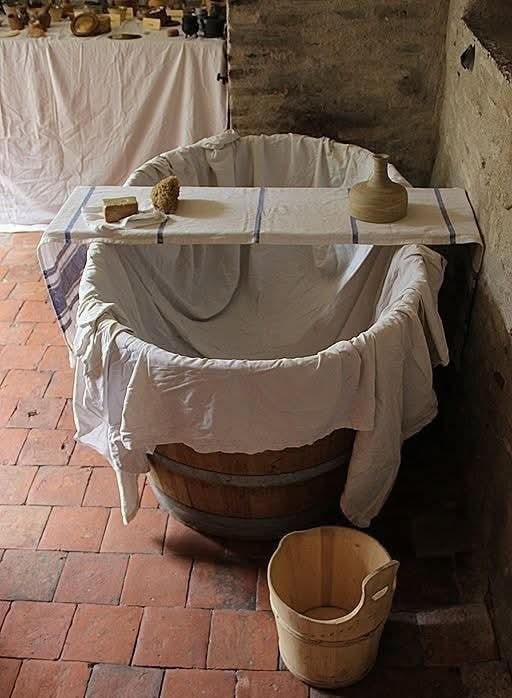
Voilà quelques explications sur l'origine des expressions
9 notes
·
View notes
Text
The Heroes, Part Three
The façade of Corinthe, half demolished, was hideous. The window, tattooed with grape-shot, had lost glass and frame and was nothing now but a shapeless hole, tumultuously blocked with paving-stones.

Bossuet was killed;

Feuilly was killed;

Courfeyrac was killed;

Joly was killed;

Combeferre, transfixed by three blows from a bayonet in the breast at the moment when he was lifting up a wounded soldier, had only time to cast a glance to heaven when he expired.

Marius, still fighting, was so riddled with wounds, particularly in the head, that his countenance disappeared beneath the blood, and one would have said that his face was covered with a red kerchief.

Enjolras alone was not struck. When he had no longer any weapon, he reached out his hands to right and left and an insurgent thrust some arm or other into his fist. All he had left was the stumps of four swords; one more than François I. at Marignan.

Homer says: “Diomedes cuts the throat of Axylus, son of Teuthranis, who dwelt in happy Arisba; Euryalus, son of Mecistæus, exterminates Dresos and Opheltios, Esepius, and that Pedasus whom the naiad Abarbarea bore to the blameless Bucolion; Ulysses overthrows Pidytes of Percosius; Antilochus, Ablerus; Polypætes, Astyalus; Polydamas, Otos, of Cyllene; and Teucer, Aretaon. Meganthios dies under the blows of Euripylus’ pike. Agamemnon, king of the heroes, flings to earth Elatos, born in the rocky city which is laved by the sounding river Satnoïs.” In our old poems of exploits, Esplandian attacks the giant marquis Swantibore with a cobbler’s shoulder-stick of fire, and the latter defends himself by stoning the hero with towers which he plucks up by the roots. Our ancient mural frescoes show us the two Dukes of Bretagne and Bourbon, armed, emblazoned and crested in war-like guise, on horseback and approaching each other, their battle-axes in hand, masked with iron, gloved with iron, booted with iron, the one caparisoned in ermine, the other draped in azure: Bretagne with his lion between the two horns of his crown, Bourbon helmeted with a monster fleur de lys on his visor. But, in order to be superb, it is not necessary to wear, like Yvon, the ducal morion, to have in the fist, like Esplandian, a living flame, or, like Phyles, father of Polydamas, to have brought back from Ephyra a good suit of mail, a present from the king of men, Euphetes; it suffices to give one’s life for a conviction or a loyalty. This ingenuous little soldier, yesterday a peasant of Bauce or Limousin, who prowls with his clasp-knife by his side, around the children’s nurses in the Luxembourg garden, this pale young student bent over a piece of anatomy or a book, a blond youth who shaves his beard with scissors,—take both of them, breathe upon them with a breath of duty, place them face to face in the Carrefour Boucherat or in the blind alley Planche-Mibray, and let the one fight for his flag, and the other for his ideal, and let both of them imagine that they are fighting for their country; the struggle will be colossal; and the shadow which this raw recruit and this sawbones in conflict will produce in that grand epic field where humanity is striving, will equal the shadow cast by Megaryon, King of Lycia, tiger-filled, crushing in his embrace the immense body of Ajax, equal to the gods.

28 notes
·
View notes
Text
La marelle : un jeu initiatique ?

L’autre jour en me baladant en ville, j’ai croisé un jeu de la marelle peint au sol. Je n’en avais pas vu depuis mon enfance, où j’y jouais à la cour de récré.
Et puis ce jour là, des années après, une pensée m’a frappé : est-ce que le jeu de la marelle serait en fait une référence à l’arbre des Sephiroth de la Kabbale depuis le début ⁉️

Sur ce modèle-ci, on peut diviser les différents Sephiroth en 4 parties, comme celles dans la pastille en bas sur l’image ci dessus.
L’arbre de la Kabbale peut être appréhendé sous 4 paliers : le monde de l’action (qui correspond au corps physique, malkuth/le royaume de la matière, c’est notre point de départ), le monde de la formation (qui correspond au cœur, iesod/hod/netsah), puis le monde de la création (correspondant à l’intellect, tipheret/geburah/hesed), et enfin le monde des émanations (l’âme, binah/hokmah/kether, l’ain soph aur, l’infini, l’absolu, enfin vous voyez le topo).
En cherchant d’autres « patterns » du jeu de la marelle, je suis retombé.e sur celui de mon enfance :

Et l’association de chaque case à une séphira de la kabbale se révèle encore plus évidente sur ce schéma !
Même Daat, la séphira *cachée* dans laquelle toutes les autres sphères sont unies, y a sa place.
Cependant, une des curieuses différences entre l’arbre de la kabbale et notre jeu de la marelle est l’inversion des nombres :
Kether (la couronne) est sensée être la sphère 1, celle dont a émané toutes les autres, et Malkuth, la dernière, celle où nous sommes piégés dans la matière.
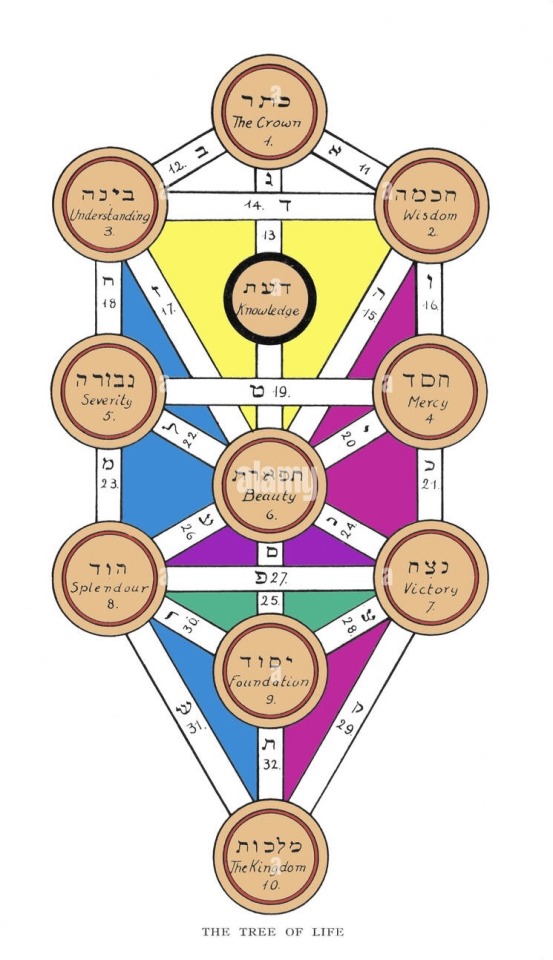
La marelle nous offre au contraire Malkuth comme la case 1, car c’est notre point de départ. Il s’agit de remonter l’arbre des sephiroth en sens inverse, jusqu’à la source.
Mais au fait, d’où ça nous vient la marelle au juste ? 🤔
L’origine de ce jeu est ancienne et prends ses racines à divers endroits du globe : des traces furent retrouvées en Grande-Bretagne, en Égypte et Grèce antiques, sur le forum de Rome, jusqu’en Inde d’où elle semble prendre sa source. Elle est entre autre mentionnée dans les Dialogues de Bouddha, au Vème siècle avant J.C., et même en Chine vers 2357 avant notre ère, sous le nom de jeu du dragon.
Dans l’empire romain, on en fit un exercice militaire, afin d’entraîner les soldats au saut à cloche-pied en cas de blessure.
À l’origine, le dessin comprenait 7 cases (comme sur la première photo que j’ai partagé) et progressivement de nouvelles versions à 10 cases ont vu le jour. Je n’ai pas pu trouver d’explications ou de sources sur pourquoi le nombre de cases a évolué au fil du temps, mais les premiers écrits kabbalistiques remontent à l’an 1130, donc après l’invention de la marelle elle-même.
On pourrait alors questionner un potentiel syncrétisme entre les deux, qui expliquerait pourquoi son évolution colle si bien à la répartition des sephiroth de l’arbre de vie.
Le jeu apparaîtrait alors comme un moyen d’apprentissage hermétique, une première étape initiatique pour se familiariser avec les concepts plus profonds de la Kabbale. L’agilité physique et l’équilibre reflétant la discipline mentale nécessaire à cette remontée. La marelle nous montre aussi que le chemin ne peut se faire qu’en remontant les cases dans l’ordre : pas de raccourci possible pour réussir l’ascension, chaque case (ou sephiroth symbolique) marque une étape nécessaire.
Pour celleux qui font preuve d’attention, on peut identifier des restes d’un passé ésotérique très influent qui survivent un peu partout dans les petites choses de notre quotidien, dans ces couches subtiles qui forment le socle commun de notre culture.
Et vous, aviez-vous réalisé ce rapprochement entre les deux ? 😉
#french witchblr#french witches#kabbale#qabbalah#sephiroth#arbre de vie#marelle#magie#occultisme#ésotérisme#hermetisme
14 notes
·
View notes
Text

Places where you can read your favourite fanfic // meilleur endroit pour profiter des dernières pages : plage de l'île Tudy, Bretagne, France
@pebblysand ✨😎🌞
5 notes
·
View notes
Text
Menace de ZOG contre le Groenland : les patriotes danois disent à Trump « d’aller se faire foutre ».
Il était temps.

Enfin quelqu’un au Danemark s’est réveillé face aux menaces d’annexion armée du gangster orange.
Anders Vistisen appartient au Parti du Peuple Danois, une formation nationaliste représentée au parlement européen.
Le Groenland n’est pas à vendre. Le Groenland fait partie du Danemark depuis 800 ans, soit plus du double de la durée d’existence des États-Unis.
Tout vrai patriote devrait comprendre qu’il s’agit d’une atteinte inacceptable à la souveraineté nationale !

Matériellement, je suis à peu près certain que l’armée danoise viendrait à bout de n’importe quelle force d’invasion terrestre américaine, même à dix contre un. L’armée américaine se bornerait à organiser le blocus du Groenland pour affamer les troupes danoises et cela serait effectivement suffisant pour l’annexer.
La quasi absence de réactions en Europe après ces menaces contre le Danemark démontre que ces états croupions européens ne pèsent rien au 21e siècle et qu’ils peuvent être menacés ouvertement, et demain dépecés, faute d’une puissance organisation politique et militaire unifiée pour se défendre.
Les nationalismes européens actuels des Meloni, Farage, Weidel ou Le Pen ne sont en réalité que des micro-nationalismes à ce stade de l’histoire. Ou plutôt des micro-populismes car ils ne développent même pas les éléments de base du nationalisme et sont des versions à peine amendées de leur centre-droit domestique. Personne ne peut prendre au sérieux ces gens face à des leaders comme Xi Jinping, Trump ou Poutine.
Le populisme est une plaie. Il se nourrit du ressentiment de segments de la société sans jamais les dépasser pour proposer un projet révolutionnaire. La seule chose qui les sauve est leur discours sur l’immigration, généralement si édulcoré qu’on sait qu’il ne serait jamais suivi d’effet sinon marginalement.
Ces micro-populismes ne proposent rien de stratégique qui soit mutuellement utile pour faire face aux menaces qui proviennent de toutes les directions contre l’Europe.
Quand on creuse, on s’aperçoit que l’énergie motrice de ce populisme décliné ici et là en Europe est une forme de nihilisme. Ces gens veulent « sortir de l’UE », « détruire Bruxelles », et quand on regarde leur alternative, il n’y a rien.
C’est une pure rage, essentiellement impuissante, de destruction à peine compensée par des promesses évasives d’un retour aux années 1960.
En France, les gens n’ont tout simplement pas compris que l’État français n’est plus une puissance significative et n’a plus les moyens de l’être, pas plus que les cités grecques ne sont redevenues des puissances méditerranéennes après leur annexion par Rome.
On entend des gens affirmer qu’il faut trouver un « Trump français » avec un pays qui pèse le poids du Texas. L’incapacité à appréhender l’ordre de grandeur des blocs continentaux en mouvement aujourd’hui est tout simplement aberrant.
Ce populisme est identique au monarchisme au 19e siècle, une pure réaction, impuissante, qui se complet dans un passéisme incapacitant et qui se réfugie progressivement dans une protestation de principe. Malgré toutes les tentatives, le monarchisme d’Ancien régime a échoué car il n’y avait plus de place pour lui dans le monde des révolutions industrielles. Là où il a survécu en Europe, c’est sous la forme d’un folklore protocolaire.
« Sortir de l’UE » signifie concrètement « rentrer en France ». Mais que signifie « rentrer en France » ? Rien de plus que d’être dirigés par les tocards du parlementarisme comme Delogu ou Attal. Cela ne changerait strictement rien, pas plus que le Brexit n’a changé quoi que ce soit en Grande-Bretagne, si ce n’est donner plus complètement la main à une élite radicalisée qui a répondu à la question migratoire par la submersion accélérée du pays. Les Roumains et les Polonais ont bien été chassés d’Angleterre, remplacés par des Pakistanais, des Indiens et des Nigérians.
Farage en est aujourd’hui réduit à expliquer qu’il est urgent pour les Anglais de s’entendre avec les Musulmans du pays. Dans le registre nationaliste, ce n’est même pas le dixième de ce que proposait un Mosley qui lui-même affirmait déjà que l’Europe devait être unifiée d’une façon ou d’une autre.

La situation est si critique que même unie, l’Europe fera face à une lutte pour survivre.
Si elle existait toujours en 2050, l’UE pèserait le tiers de l’économie chinoise.

Les micro-populismes regardent le passé et le confondent avec l’avenir. En prolongeant 1848 avec cette idée de restaurer la souveraineté de leurs états nationaux, ils jurent que ces cités-états feraient face isolément à des empires mondiaux nord-américain, chinois ou russe d’égal à égal.
C’est de la science-fiction.
Citer De Gaulle n’a aucun sens dans le monde actuel. Dans les années 1960, l’économie mondiale était réduite aux USA et à l’Europe occidentale. En termes relatifs, la France était encore une puissance influente dans un petit carré de pays développés limités à l’Occident. Avec une Allemagne coupée en deux, le « souverainisme » gaulliste, d’ailleurs relatif puisque la France gaulliste était dans l’OTAN, était un pragmatisme. Dans un espace mondial d’où a disparu le communisme et où les grands blocs capitalistes s’affrontent sous la direction de deux géants, la Chine et l’Amérique, ce souverainisme tactique n’aurait aucune prise sur les grandes réalités.
Qui imagine une discussion bilatérale équilibrée entre la France arabo-négrifiée de 2050 et la Chine et son tiers du PIB planétaire ? La France ne tient même plus tête à l’Algérie.
Ce qui est vrai pour la France est vrai pour tous les états européens et leur micro-populisme sans intérêt. Si demain la Turquie envahit la Grèce et les Balkans, et Erdogan ne fait pas mystère de le vouloir à la première occasion, que feront-ils ? En l’état actuel, rien. La seule chose qui retient Erdogan, c’est l’armée américaine.
La France s’est faite dégager de l’Afrique francophone sans rien pouvoir faire, ce n’est qu’une question de temps avant que d’autres n’attaquent directement le continent pour le dévorer morceau par morceau.
Il est temps que la discussion dépasse ces micro-populismes impuissants ou l’Europe en intégralité, France comprise, sera démantelée, occupée, pillée, et évidemment submergée démographiquement.
Nous avons besoin d’une mise à jour idéologique, stratégique, politique, et de raisonner conformément à la réalité du 21e siècle plutôt que s’accrocher à un cadre historique qui n’opère plus. La vérité est que le micro-populisme est un luxe offert par l’OTAN en ce qu’il tempère encore les forces extérieures, mais c’est temporaire.
Si les esprits restent gouvernés par l’imaginaire gaullo-communiste, les Français seront tous musulmans d’ici deux générations.
Démocratie Participative
2 notes
·
View notes
Text

S’il fallait comparer Le Pen à un autre Breton, ce n’est pas Duguesclin qu’il faut citer, mais Jord Kadoudal, né à Brec’h, à 20 kilomètres de la maison natale de l’homme de la Trinité. Une adhésion viscérale, jusqu’à la naïveté, à l’ordre hérité de la tradition au beau milieu de l’effondrement d’un monde, une virilité combative, une ténacité, un idéal et une volonté. En ces temps périlleux, la nation bretonne regagnera sa place dans l’histoire quand elle saura trouver et mettre à son service les hommes d’une telle qualité pour la mener. Qu’il plaise à la Providence de donner à la Bretagne des chefs de cette trempe.
Ewen Broc’han
2 notes
·
View notes
Text
THE MATAGOT, THE SILVER CAT (FRENCH FOLKLORE)
LE MATAGOT, OU CHAT D'ARGENT : (Folklore de France)

''The silver cat, mandragot or matagot is, in the folklore of Brittany, Gascony, Provence, and Languedoc, a generally black and evil cat obtained by a sorcerer in exchange for his soul. He is supposed to wander through some mysterious places during the night, and return at dawn with a stock of gold louis for his master. If the cat neglects it or does not reward it, the cat becomes offended and can take cruel revenge. Sometimes this cat is said to serve not one, but nine masters, and lead the last one to hell.'' (Source Wikipedia)
🇲🇫
''Le chat d'argent, mandragot ou matagot est, dans le folklore de Bretagne, de Gascogne, de Provence, et du Languedoc, un chat généralement noir et diabolique obtenu par un sorcier en échange de son âme. Il est censé se promener dans quelques lieux mystérieux pendant la nuit, et revenir à l'aube avec un stock de louis d'or pour son maître. Si celui-ci le néglige ou ne le récompense pas, le chat s'offense et peut se venger cruellement. Parfois, ce chat serait censé servir non pas un, mais neuf maîtres, et conduire le dernier en enfer.'' (Source Wikipedia)
#witches#french folklore#witch folklore#devil folklore#the devils cat#matagot#chat d'argent#cats folklore#cats#black cats
4 notes
·
View notes
Text
Les Contes du Korrigan (1)
I want to share with you a fairytale-related BD (bande-dessinée, aka a comic book) that was part of my childhood and is, I think, quite a good way of visually exploring Breton fairytales: "Les Contes du Korrigan", "The Korrigan Tales" (or "The Tales of the Korrigan" depending on how you wish to translate it, both versions can be justified)

Fun fact: the image right above is the cover of the first volume as published in the Breton dialect! Les Contes du Korrigan got a bilingual publication - one in French, and one in the Breton language.
Les Contes du Korrigan is a BD series created by Jean-Luc Istin and the Le Breton duo (Erwan and Ronan - they wrote the scenario, while Istin did a part of the art and oversaw the organization and creation process). Its principle is quite simple: it is an anthology of fairytales and legends from the Bretagne region of France (Britanny as you call it in English, aka the "Little Britain" opposed to the "Great Britain"), reinvented in a comic book format. The title comes from the fact that our narrator, who is the protagonist of every frame story and presents individual tales, is a korrigan.
The korrigans are one of the most famous parts of the Breton folklore. They are basically Bretagne's local variation of the "lutin" (imp/sprite) and of the "nain" (dwarf) - "korr" actually is the Breton word for a dwarf. In folklore, korrigans are known to be ugly, hairy, horned and hooved little men - and they were of course strongly associated with devils and demons when the Breton folklore was christianized. The female korrigans are sometimes described as beautiful fairies or seducing enchantresses, though just as mischievious as their male counterpart. Anyway, I am not here to make a folklore lesson about korrigans (though I could if you are interested), but to share this comic:





What you see above is the opening segment of the first book of the series, "Les Trésors Enfouis" (Buried Treasures). We meet our narrator and story-host, Koc'h the korrigan. A Breton name which is pronounced "korr" like "korrigan" (he insist that it is not pronounced "kosh" or "kok"). He begins by reciting a poetic hymn to the glory of Bretagne in front of a korrigan statue, before a bird comes to poop on said statue. The bird in question isn't actually a bird, but a metamorphosis of Skoul, that Koc'h insults and chases away, promising that once turned to stone he will make a "beautiful gargoyle, when mankind invents cathedrals... in five thousand years." Indeed, this sequence is actually taking place while humanity and korrigans work together to erect menhirs and dolmens for their gods - offerings of stone, baptized in sweat and blood, and which will honor the Celtic deities for centuries to come, and shall be the last home of the korrigans when "the time of oblivion shall come"...
Koc'h offers a helpful little guide of the great "families" of the supernatural folks of Bretagne. You have the korrigans, "the people of the mounds", also called korrig, kornandon, polpigan. You have those "of the moors and the bogs", the "tan-noz", that the French people call "feux follets" (aka will o the wisp). There's the "morganed", "our brothers and sisters of the reefs". They form the "small people" or "little folk" - but they are not the only inhabitants of the Otherworld who also haunt Bretagne.
There are also the "anaon" - the unresting souls and travelling wraiths, who sometimes have to wait for centuries before they can reach purgatory or the "isles of the afterlife". The "shepherd of this sinister flock" is of course the Ankou, the reaper of the dead - renowned for his badly-oiled, creaking chariot, and for his scythe with an upside-down blade. His three "sisters" are the kannerez noz, the night washerwomen, who only attack men and offer them to help wash their own shroud... And finally there are the many "bugul noz" (the screaming spirits), most famous of which being Yannig an aod, "Jeannot de la grève", "Johnny of the beach" - these spirits will beg and implore for your help, but if you lend them a hand at best you'll lose your arm, at worst your life...
Such is Koc'h conclusion: it is no good to do business with the dead in Bretagne, while on the contrary, the Little Folks are all laugh, feasting and merriment! And it is to honor this tradition that Koc'h invites us to listen to the stories that forged the soul of the Bretagne peninsula - told in his own, korrigan-styled way...
And who is Skoul, you ask? Skoul is a bogeyman of Bretagne. His name means "bird of prey", or "kite", and he was a malevolent, lifeforce-stealing entity known to attack as much adults as children.

6 notes
·
View notes
Text


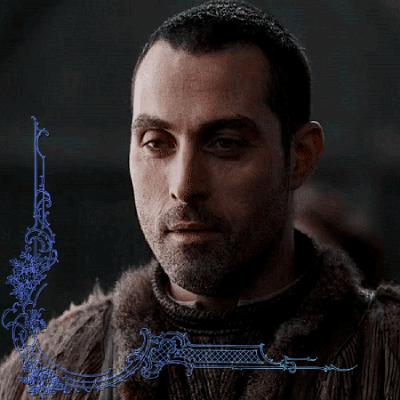

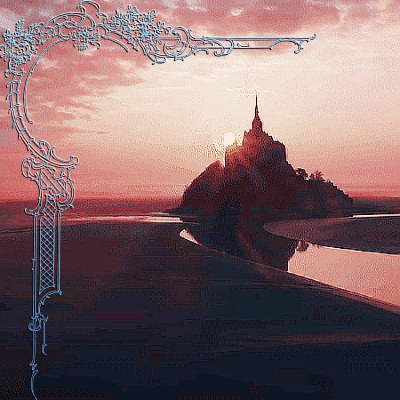


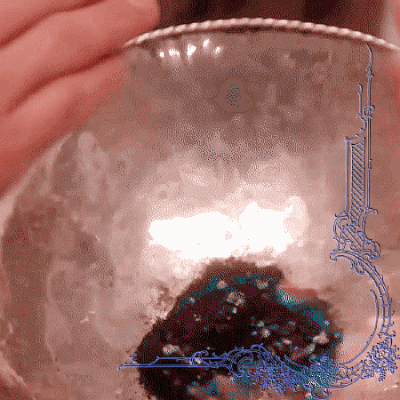
Havoise was therefore given to Geoffrey more christiano. The chronicler’s desire to clarify this detail suggests that not all marriages were concluded in Normandy in this way at the time. And, indeed, the union (probably decided during this Breton stay in Normandy) which took place a few years later between Geoffrey’s sister and Richard was not described by Guillaume de Jumièges in the same way. Richard, receiving Judith with honors, joins her more legitimo. Richard therefore did not marry the young Breton girl more danico because, as a Christian prince, he henceforth complied with the rules fixed since the Carolingian era. Did he follow the customs that the Bretons respected?
The view taken by the Norman princes on marriage differed from that of the Bretons: Richard II, like his father, his grandfather and his great-grandfather, was born from a concubine. In Brittany, a “legitimate” birth appeared to be a major condition for accession to the ducatus. The “Christian way” that Geoffrey wanted to have in uniting himself to Havoise suggests, moreover, a religious ceremony, which the Breton princes have perhaps been practicing for centuries. The meeting place chosen - the Mont - to hand over to her Norman husband suggests that Geoffrey would have liked it to be the same for his sister. This was not done, the law or the legal practices to which a woman belonged being thus questioned or even forgotten during her marriage, as if she now depended on the customs known her husband’s lands.
-Joëlle Quaghebeur, Havoise, Constance, et Mathilde, princesses de Normandie et duchesses de Bretagne
#historyedit#havoise de normandie#richard ii de normandie#geoffrey de rennes#judith de rennes#tenth century#eleventh century#my edit
30 notes
·
View notes